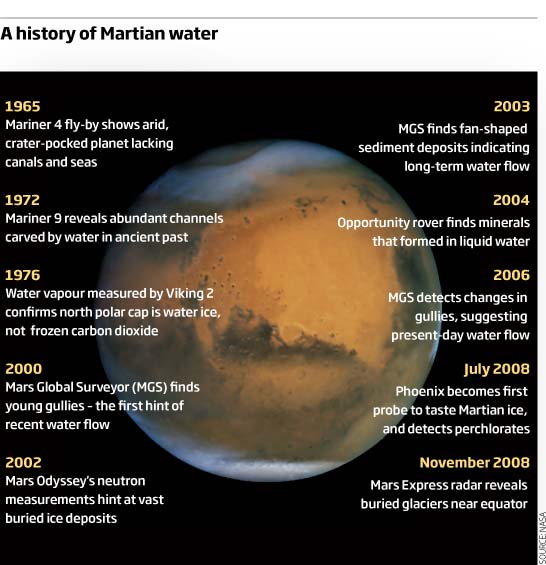
© UnknownA history of Martian water
There's nothing like a little antifreeze to thaw out a frozen planet. Thanks to chemicals called perchlorates, liquid water may play a bigger role on Mars than expected, which is good news for the search for life.
Last year, NASA's Phoenix lander team announced the unexpected discovery on Mars of perchlorates - compounds containing an atom of chlorine bound to four oxygen atoms. Relatively sparse on Earth, they turn out to be abundant on Mars, forming 1 per cent of the soil tasted by Phoenix.
The initial excitement focused on whether Martian microorganisms could use perchlorates as food, as some Earth microbes do. That remains possible, but now it's emerging that perchlorates could have far-reaching consequences on Mars for another reason: their ability to keep water liquid far below 0 °C.
The Phoenix measurements could not distinguish between different kinds of perchlorates, but the most likely candidates are magnesium and sodium perchlorate, based on the abundance of magnesium and sodium ions that Phoenix detected. Concentrated solutions of these salts can stay liquid down to -72 °C and -37 °C respectively.
That makes it possible for liquid water to play a bigger role in shaping modern Mars than previously thought, despite temperatures that are usually far below zero. Pockets of water could persist just below the surface, insulated by the soil above, and might occasionally flow across the surface. "It's possible to have [liquid] almost everywhere where there is ice and the temperature goes above this threshold value - that's most of Mars," says Phoenix team member Nilton Renno of the University of Michigan in Ann Arbor.
This could explain gullies on Martian slopes that look much like water-carved features seen on Earth and seem to have formed recently. "A handful of people have argued for brines being the source of gullies, [but] there was nothing we had seen before that could form brines at those temperatures," says Michael Hecht of NASA's Jet Propulsion Laboratory in Pasadena, California, and the lead scientist for the instrument that found the perchlorates.
Perchlorate-laced water might also accumulate beneath glaciers and help them slide around, which could explain signs that extremely cold and stiff glaciers on Mars's northern ice cap have flowed over time, according to a study by David Fisher of the Geological Survey of Canada in Ottawa, to be presented in March at the Lunar and Planetary Science Conference (LPSC) in Houston, Texas. "The ice is deforming very little but it moves on top of this mobile sludge bed," Fisher says.
Fisher thinks some perchlorate-rich water beneath glaciers might end up trickling deep underground through cracks in the rock, providing a crucial source to replenish Martian groundwater. Groundwater appears to have leaked onto the surface in numerous episodes over Martian history, leaving dried-up river channelsMovie Camera and evidence of ancient hot springs.
Perchlorate-rich water droplets might even explain some mysterious bumps on Phoenix's leg that appeared to flow and merge, according to a study led by Renno that will also be presented at the LPSC. Others, including Hecht, think they are more likely to be lumps of ice, with changing light giving the illusion of liquid-like behaviour.
If pockets of liquid water exist on present-day Mars, they might even support life, says Renno. The most concentrated perchlorate solutions would be unlikely to support life, but milder solutions could allow liquid and thus life to exist.
Reader Comments
to our Newsletter